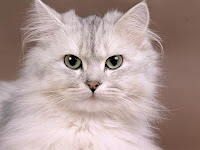 With the holidays quickly approaching, it is easy to become distracted by long to-do lists. Be sure that YOUR CAT is included in your holiday planning.
With the holidays quickly approaching, it is easy to become distracted by long to-do lists. Be sure that YOUR CAT is included in your holiday planning.
Enjoy the holiday delicacies, but be very aware that most table food is not appropriate for your cat. Reactions from unusual and inappropriate foods can range from mild gastrointestinal upset to severe toxicity. Beware of chocolate, onions, garlic, fatty meat scraps, bones, poultry carcass and meat wrappings/strings. A few small pieces of cooked unseasoned meat as a topping to their regular meal should not be a problem for most cats, after all, it is a celebration!
Deck the halls. Safely! Secure your Christmas tree to prevent tipping, especially if your feline is prone to climbing or you have a kitten. Avoid any water additives for made to prolong the life of your tree. Many of these can be harmful to your cat if they chose to sample ‘the new water bowl’. Avoid fragile ornaments or lights. Tinsel is especially dangerous to cats as many find the texture irresistible for chewing that could lead to an intestinal blockage if ingested. Shiny bows and sparkling ribbons can easily become cat toys, and be ingested. Many common holiday plants (holly, mistletoe, lilies, and poinsettia) are dangerous if eaten.
Deck the halls. Safely! Secure your Christmas tree to prevent tipping, especially if your feline is prone to climbing or you have a kitten. Avoid any water additives for made to prolong the life of your tree. Many of these can be harmful to your cat if they chose to sample ‘the new water bowl’. Avoid fragile ornaments or lights. Tinsel is especially dangerous to cats as many find the texture irresistible for chewing that could lead to an intestinal blockage if ingested. Shiny bows and sparkling ribbons can easily become cat toys, and be ingested. Many common holiday plants (holly, mistletoe, lilies, and poinsettia) are dangerous if eaten.

Visitors can be stressful; especially for your cats. Provide a safe cat sanctuary as a retreat if things become boisterous. Cats may feel uncertain about traveling through high traffic areas to get to their food and water or litter box. Be conscious of open doors. As new guests arrive, be sure to safeguard against the opportunity for an unplanned outside cat adventure. FELIWAY is your cats best friend around the holidays. Use it daily to help your cats thru the chaos of holiday parties, company, visitors.
Traveling with your cat? Be sure to desensitize your cat with frequent, short trips before jumping into the car for a trip over the river and through the woods. Ask your veterinarian for treats or supplements that may lower their anxiety levels; many of which should be started days or weeks before leaving. FELIWAY is a great product for use in the car and carrier. Be prepared to make frequent stops for the comfort of your cat and schedule accordingly. Create a pet packing list! Include bowls, litter, medications, comfort items, and of course their favorite food. COMPOSURE is a cat treat that is formulated to help your cat handle stressful situations. NUTRICALM is a liquid supplement that is a great addition to a cat's canned food in times of change.
If your cat is on prescription medication or a veterinary prescription food, be sure to stock up before the holidays. Know your veterinarian’s holiday schedule. If an emergency happens and your cat needs veterinary assistance, do you know where to go and who to call if your regular veterinarian is closed for the holidays? It is always good to have an emergency number handy in case it’s needed. This is true especially during holidays when normal business hours may be unpredictable.
The holidays should be a special time for both you and your cats. Preventing the unexpected is the key. Be safe. From our cats to yours, have a purrrrfect Holiday Season!














